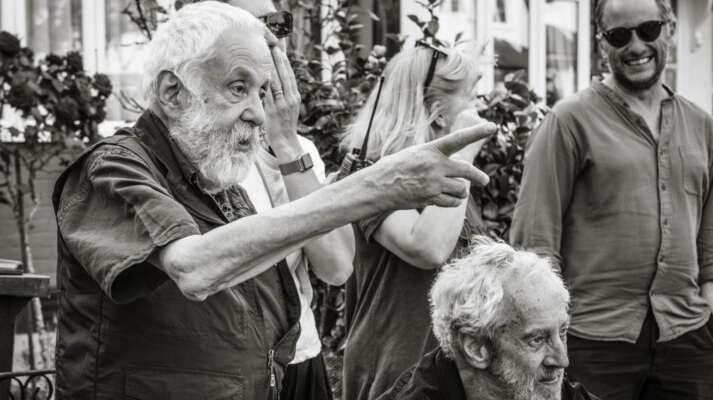A Trip to Devil's Island
A look at the history and lore behind the infamous prison in Papillon
A Trip to Devil's Island
Written by Peter Bowen
Michael Noer's Papillon recreates the world of its title hero (Charlie Hunnam) and his friend Louis Dega (Rami Malek) as they attempt to escape the notorious Devil's Island prison. Of the 80,000 sent there, few returned to Paris after serving their sentences. Papillon was one of the only two successful prisoner escapes from the collection of islands off French Guiana. "It was hellish over there, and not only the prison," explains Malek, who read several prisoner accounts of the horrors. "Disease was rampant, and a lot of people died from malaria. Many prisoners never made it back to their homeland, whether they served out their full term at the penal colony or not." To give a fuller picture of the world that Papillon and Dega found themselves in, we put together a brief history of the prison, both in real life and fiction.
The islands of salvation
The prison often referred to as Devil's Island is in fact three islands called Îles du Salut, as well as a larger penal colony on the mainland. The name, Îles du Salut (Salvation's Islands), which was given by missionaries who encamped there to escape an outbreak of plague, would prove cruelly ironic over time. In 1852, the government of Emperor Napoleon III established the islands and part of French Guiana as a penal colony. In 1854, France instituted the policy of doublage, a rule that forced prisoners serving less than eight years to remain on the island for a period equal to their sentence. Those with longer sentences were exiled for life. The rule hardly mattered since most would not live long enough to leave. About forty percent of the prisoners who arrived would be dead within a year. The majority of prisoners were first sent to St-Laurent-du-Maroni on the coast, where they would be assigned to work gangs to clear forests and build roads. Political, dangerous, and incorrigible prisoners were sent to Îles du Salut. In 1889, the French government started sending female prisoners as well in hope they would stay and settle on the colony. The policy was abandoned a few years later.
Of the three islands that make up Îles du Salut, the largest island, Île Royale, served as the administrative center of the prison. In addition to housing prisoners, Île Royale acted as the reception port for new inmates and housed the administrative offices, including the warden who lived in a grand estate on the island's central hill. The worst prisoners were kept in the Crimson Barracks, so named for the vast amounts of blood spilled in prisoner-on-prisoner violence. "In that one spot, more murders have been done than in any place on earth of such restricted space," wrote René Belbenoît in Dry Guillotine. The island's guillotine was centrally located and used regularly to demonstrate to all the warden's absolute power. To get a glimpse of life on Devil's Island, go to the Papillonmovie Instagram account for a remarkable collection of archival photos, as well as images about the making of the film.

The southernmost island, Île Saint-Joseph, housed Camp Reclusion where prisoners were sent for solitary confinement. The place was cursed as "the devourer of men" for the high percentage of prisoners who lost their minds while caged there. The smallest and northern most island, Île du Diable, was specifically set up for political prisoners. Its sheer cliffs and shark-infested waters made it nearly impossible to escape. In 1855, the governor of French Guiana, Louis Adolphe Bonard wrote, " with no police on Devil's Island, they [political prisoners] can freely debate their theories," suggesting that their intellect itself would prove punishment enough.
Famous guests
Next to Henri "Papillon" Charrière, perhaps the Island's most famous guest was Alfred Dreyfus, the Jewish French Army captain who was unjustly convicted of treason in 1895 and sent to Devil's Island. Even after evidence appeared the next year that exonerated him, the French government refused to act. Nearly all of France seemed to line up on one side or the other on the Dreyfus affair, a massive culture war that pitted the army and conservatives against the press and left-leaning intellectuals. When the French government finally pardoned him, but let his conviction stand, Dreyfus returned to France a broken man. The public attention on Dreyfus also pointed an international spotlight on the conditions experienced by prisoners on Devil's Island, giving it a reputation as one of the most terrifying places on earth.

Besides Papillon, the only other inmate who successfully escaped was Clément Duval, a French anarchist who was arrested in France for robbing a mansion and stabbing a policeman in 1886. His death sentence was commuted to hard labor on Devil's Island. In 1900, after 20 attempts, he finally made it off the island. Setting up home in New York City, he wrote Outrage: An Anarchist Memoir of the Penal Colony.
In 1938, a few years before Papillon allegedly escaped Devil's Island, René Belbenoît published his memoir of being a prisoner entitled Dry Guillotine, a term prisoners used to describe life there. In 1920, Belbenoît arrived at the penal colony for an eight-year sentence. His multiple, unsuccessful attempts to escape extended his stay until 1934. Released but forced to stay on the island, Belbenoît eventually found a way to the mainland, slowly winding his way north to New York City where he published his memoir. The book's popularity, unfortunately, caught the attention of the US Immigration department that deported him as an illegal immigrant. Eventually, Belbenoît made it back to America. This time he headed west where he became a technical advisor at Warner Brothers.
The Island Now
While the French stopped sending prisoners to Devil's Island in 1938, it would take another 15 years before they would completely close down the complex. A few year's after its closure, it became part of the Guiana Space Center, monitoring the research and telecommunications rockets launched from the mainland town of Kourou.

In the last few years, Devil's Island has also become an unexpected tourist destination. Boats leave Kourou in the morning for Île Royale, giving visitors the full day to visit the director's estate (now a museum), the old barracks, prison, hospital, and chapel, before returning to the mainland in the afternoon. "Tropical island charm. Lovely palm trees and ocean views," wrote one recent visitor on TripAdvisor. For those who want a more immersive experience, there is a small hotel on Île Royale. Limited travel is available to Île Saint-Joseph, but Île du Diable is off limits to all visitors.
Devil's Island in the popular imagination

While the facts of Devil's Island are horrible enough, nothing could match the fearful fantasies conjured up in the public imagination by the mere whisper of its name. It has been the subject of many films, as well as a talking point in countless others. While often used to signify sadistic horror, Hollywood has also found its romantic side. The 1926 silent film Devil's Island uses the famous prison as the setting for a tragic love story. An early talkie, the 1929 film Condemned, stars Ronald Colman in Devil's Island as "a rough, tough convict who'd kill for a kiss," or so the poster promises.
To mark the prison's closing, Warner Brothers put out William Clemens' B-movie Devil's Island with Boris Karloff as a sympathetic doctor who, convicted for political reasons, must now face sadistic guards and dangerous inmates. Before the film was even released, the French government, fearing the terrible publicity, persuaded Warner Brothers to cut it down severely. The same year, MGM released Frank Borzage's mystical melodrama Strange Cargo with Joan Crawford and Clark Gable about prisoners fleeing Devil's Island. In later year, the place became more punch line than prison. Domenico Paolella's 1962 sexploitation movie Women of Devil's Island turned the island into a costume drama of beautiful women and cruel guards.

In popular literature, writers would often use Devil's Island to signify a dark past or horrible fate. In Dashiell Hammett's The Dain Curse, for example, the detective learns in the process of solving a murder that one reclusive, wealthy San Franciscan had covered up the fact he had escaped from Devil's Island. Comic books, like the 1952Escape from Devil's Island, reveled in the gaudy and gory sensationalism the name evokes.


